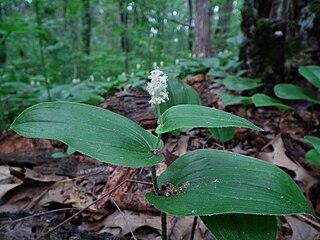
Maianthemum canadense is an understory perennial flowering plant, native to Canada and the north-eastern United States, from Yukon and British Columbia east to Newfoundland, into St. Pierre and Miquelon. It can be found growing in both coniferous and deciduous forests. The plant appears in two forms, either as a single leaf rising from the ground with no fruiting structures or as a flowering/fruiting stem with 2-3 leaves. Flowering shoots have clusters of 12–25 starry-shaped, white flowers held above the leaves.

Asystasia gangetica is a species of plant in the family Acanthaceae. It is commonly known as the Chinese violet, coromandel or creeping foxglove. In South Africa this plant may simply be called asystasia.

Blandfordia grandiflora, commonly known as Christmas bells, is a flowering plant endemic to eastern Australia. It is a tufted perennial herb with narrow, channelled, linear leaves and between two and twenty large, drooping, bell-shaped flowers. The flowers are red with yellow tips, or sometimes entirely yellow. It is one of four species of Blandfordia known as Christmas bells, this one growing on the coast and nearby ranges between Sydney in New South Wales and Fraser Island in Queensland.
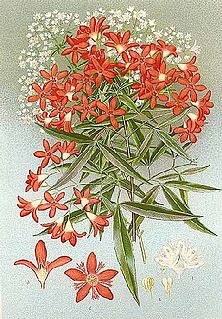
Ceratopetalum gummiferum, the New South Wales Christmas bush, is a tall shrub or small tree popular in cultivation due to its sepals that turn bright red-pink at around Christmas time. The petals are actually small and white - it is the sepals that enlarge to about 12mm after the flower sets fruit and starts to dry out.
Zeuxine exilis, commonly known as Ridley's jewel orchid or the slender jewel orchid, is a species of orchid that is endemic to Christmas Island where it grows in rainforest. It has three or four egg-shaped leaves and up to thirty small, dull reddish flowers crowded along a thin, hairy flowering stem. It was first recorded in 1904 but was not seen again until 2009.
Zehneria alba is a species of flowering plant in the cucumber and gourd family, Cucurbitaceae. It is endemic to Christmas Island, an Australian territory in the northeastern Indian Ocean. The specific epithet is from the Latin albus (white), referring to the colour of the flowers.
Dendrocnide peltata, commonly known simply as the stinging tree or jelaton, is a large tree in the nettle family Urticaceae. With the other species of the genus Dendrocnide, it is known for the stinging hairs which cover the whole plant and cause severe pain when touched. The specific epithet comes from the Latin pelta, referring to the peltate leaves.

Hoya aldrichii , commonly known as the Christmas Island Waxvine is a species of flowering plant in the Apocynaceae or dogbane family. It is a vine that is endemic to Christmas Island, an Australian territory in the north-eastern Indian Ocean, where it is a common epiphyte in the shrublands of the island's coastal terraces. The specific epithet honours Captain Aldrich, commander of the survey vessel HMS Egeria, which visited Christmas Island in 1887.
Grewia insularis is a species of flowering plant in the Malvaceae, or mallow family, that is endemic to Christmas Island, an Australian territory in the north-eastern Indian Ocean. Its specific epithet is the Latin for insular, referring to its island location.
Brachypeza archytas, commonly known as the sage orchid, is an epiphytic orchid that is endemic to Christmas Island, an Australian territory in the north-eastern Indian Ocean. It has many cord-like roots, four or five leaves arranged like a fan and a large number of small, crowded, short-lived, white flowers.
Dendrobium nativitatis, commonly known as the Christmas Island crimp orchid, is a species of epiphytic orchid that is endemic to Christmas Island, an Australian territory in the north-eastern Indian Ocean. It has long, straggly stems, flattened pseudobulbs, a single leathery leaf and a single pale yellow flower.

Ehretia microphylla, synonym Carmona retusa, also known as the Fukien tea tree or Philippine tea tree, is a species of flowering plant in the borage family, Boraginaceae.
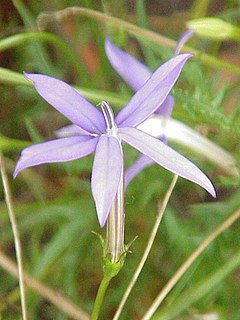
Isotoma axillaris, commonly known as rock isotome or showy isotome, is a small herbaceous perennial in the family Campanulaceae. It usually has blue or mauve star-shaped flowers from September to May. It may also be called blue star, star flower, or laurentia.

Hakea microcarpa , commonly known as small-fruit hakea is a flowering plant in the family Proteaceae and is endemic to eastern Australia. It is a spreading shrub, often growing in woodlands, heathlands and near swamps in montane areas of eastern Australia.

Zanthoxylum pinnatum, commonly known as yellow wood, is a species of flowering plant of the family Rutaceae native to Lord Howe and Norfolk Islands. It is a tree with pinnate leaves, white male and female flowers arranged in groups in leaf axils, and spherical, purple follicles containing a single black seed.

Hakea lissosperma, commonly known as needle bush and mountain needlewood, is a species of Hakea native to parts of south eastern Australia.
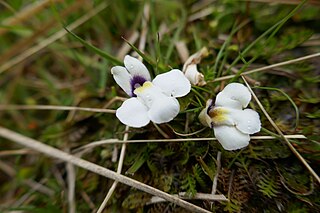
Mazus radicans, commonly known as swamp musk, is a wetland herb in the family Phrymaceae, native to New Zealand.
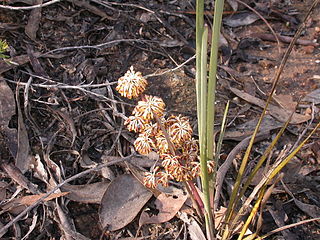
Lomandra multiflora is a perennial, rhizomatous herb found in Australia. Lomandra multiflora is also commonly known as many-flowered mat rush, mat rush and many flowered mat-lily. Lomandra multiflora is a species that is native to Australia and can be found in New South Wales, Queensland, Victoria, South Australia, Northern Territory of Australia and also in Papua New Guinea. The mat rush is distributed widely in the region and common within its preferred growing conditions. The conservation status of Lomandra multiflora is considered not to be of concern and risk.
Microtis alba, commonly known as the white mignonette orchid or slender onion-orchid, is a species of orchid endemic to the south-west of Western Australia. It has a single hollow, onion-like leaf and up to sixty small, green and white flowers with a strong musky fragrance. It is much more common after a fire the previous summer than in unburned country.
Grevillea halmaturina, also known as prickly grevillea, is a species of plant in the protea family that is endemic to Australia.











